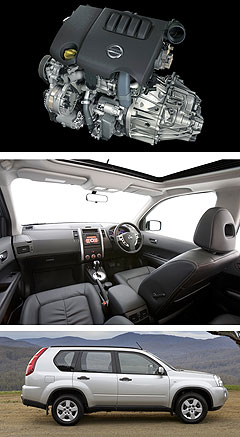First Oz drive: Diesel is sign of X-Trail times
BY PHILIP LORD | 29th Jul 2008

Aside from the 2.5-litre petrol, we were also able to sample the X-Trail dCi, a turbo-diesel model intended for European markets, but one Nissan did not see the logic in selling for the sake of it in Australia as the numbers did not stack up.
Just eight months after the launch of the petrol 2.5-litre X-Trail, Nissan Australia is now launching the X-Trail dCi.
It is not hard to see why Nissan changed its mind: X-Trail sales are lagging behind the competition, with traditional foes the Toyota RAV-4, Honda CR-V and Subaru Forester all comfortably ahead of the X-Trail in sales volume.
The all-new X-Trail introduced in October 2007 is struggling to even match the dying days of the old X-Trail’s sales.
The new X-Trail has sold 4989 units to the end of June, compared with 6250 in the same period last year. This difference in sales numbers is co-incidentally similar to the popularity of the X-Trail-based Dualis, of which 1395 have been sold so far this year.

Nissan is so confident it can sell the turbo-diesel X-Trail that it is betting on 40 per cent of X-Trail buyers choosing the diesel variant.
The new X-Trail dCi turbo-diesel has one engine available in two output levels according to transmission choice (a six-speed manual or six-speed auto) and two levels of trim - TS and TL, roughly equivalent to the ST-L and Ti specifications in the petrol models.
The price premium is $1000 over the petrol X-Trail equivalent.
With the six-speed manual transmission, the 2.0-litre common-rail inline four-cylinder turbo-diesel has 127kW of power at 3750rpm and 360Nm of torque at 2000rpm. Fuel consumption is quoted at 7.4L/100km combined and the C02 emissions are 198g/km. The 0-100km/h sprint is achieved in a claimed 10.0 seconds and maximum speed is 200km/h.
With a six-speed automatic, the 2.0-litre is detuned and instead develops 110kW at 4000rpm and a maximum torque figure of 320Nm at 2000rpm. Fuel consumption is rated at 8.1L/100km, C02 levels are 216g/km and the claimed 0-100km/h time is 12.5 seconds. Top speed is listed at 181km/h.
By comparison, the 2.5-litre petrol engine produces 125kW at 6000rpm, 226Nm at 4400rpm and has a fuel consumption average of 9.5L/100km (manual) or 9.3L/100km (CVT auto).
The new engine runs 1600-bar common-rail injection pressure with piezo injectors, a particulate filter and is Euro 4 emissions-compliant.
The new diesel weighs around 100kg more than the petrol variant, and while the dCi manual shares the petrol’s 750kg unbraked/2000kg braked towing capacity, the auto’s towing capacity is rated at 750kg unbraked/1350kg braked.
All X-Trails have a towball download maximum of 200kg, and a roof load capacity of 100kg.
The diesel employs the existing All-Mode 4x4-i 4WD system used in the petrol model. The driver can select 2WD for drive to only the front wheels (to give a slight economy benefit) or the ‘Auto’ on-demand 4X4 mode, in which drive goes to the front wheels unless wheelslip is sensed, when the system apportions drive up to 50-50 front-rear. Finally ‘Lock’ mode distributes the torque 50-50 front-rear, but it only works up to 40km/h - at which point it returns to ‘Auto’ mode.
While strictly speaking not an off-road 4WD, the X-Trail has a respectable minimum ground clearance of 200mm, approach and departure angles of 26 degrees and 22 degrees respectively and a wading depth of 350mm.
Working in conjunction with the anit-lock braking, traction and stability control systems, the new All-Mode system features sensors measuring information such as G forces, yaw rates and steering angles, which are fed to a central processor that directs drive to the wheel with most grip.
The new diesel X-Trail dCi comes in two trim designations - TS and TL.
Both models have comprehensive safety features that include twin front, front side and side curtain airbags, electronic stability/traction control (ESC), ABS, electronic brake-force distribution (EBD) and seat-belt pretensioners.
Standard features include 17-inch alloy wheels, power windows and mirrors, air-conditioning, cruise control, a six-stack CD player, trip computer, front foglights and chrome door-handles.
In addition, the top-spec TL model has power-adjustable heated leather seats, climate-control air-conditioning and a panoramic sunroof.
Both the diesel models have chromed interior door-handles (like the ST-L and Ti petrol models) but also get silver finishes around the instruments and controls. All models feature a full-sized spare wheel.
As with the 2.5-litre petrol model, the dCi is built at Nissan’s plant in Kyushu, Japan.
| X-Trail dCi range pricing: | |
| TS dCi | $36,990 |
| TS dCi (a) | $38,990 |
| TL dCi | $39,990 |
| TL dCi (a) | $41,990 |